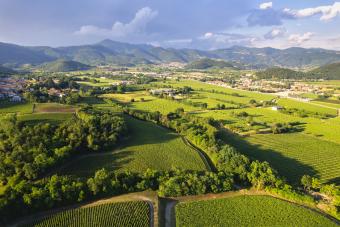
If you're searching for something a little different in a sparkling wine, perhaps something a bit fun, complex, and sophisticated without breaking the bank, welcome to Franciacorta wine. And, yes, you should read that welcome exactly as though you're being welcomed to Jurassic Park, but without the danger. Unless you're into dangerously delicious sparkling wine.
What Is Franciacorta Wine?

From the Italian province of Brescia, just over an hour east of Milan, comes the Italian sparkling wine, Franciacorta. Made from grapes grown near Lake Iseo in the Lombardi region and harvested by hand, this green wine, green in age only, emerges from a region steeped in wine history. How so? Since the Middle Ages, the Franciacorta region has been home to wineries and is certainly no stranger to the production of wine. And if you're dusty on when the Middle Ages took place, that's between the fall of Rome in the 5th century until just after the Renaissance began to take hold in the 15th century.
The Chardonnay Grape Is King

You'll find not only chardonnay grapes, but pinot noir and pinot blanc grapes as well. For those familiar with chardonnay, it's not surprising that such a buttery and smooth wine with notes of honey and stone fruit has chardonnay grapes, and those make up the bulk of the Franciacorta grapes. Pinot noir is a meager 15% of the grapes, but it does give the wine a lovely body. As for the 5% of the pinot blanc, you can give those a tip of the hat for creating a beautiful balance between all three players.
What Does Franciacorta Taste Like?

Similar to effervescent Champagne, Franciacorta shares several similar notes, but you can thank the terroir for the differences. Franciacorta tastes of citrus, buttery brioche, and bright acidity with a crisp flavor. You can expect notes of apple and pear to greet you with each sip, and the perfect mineral undertone to bring these intoxicating flavors, no pun intended, together.
Franciacorta, Soil, and Terroir

Terroir, a rather highbrow way of describing the environment in which a wine is made and all the factors such as the climate, soil, and topography, is a major factor for Franciacorta. The glacial soil you find in the region is a key player in the flavor of the Franciacorta and without it, things just wouldn't be the same.
Franciacorta Wine and Fermentation, Oh My!

Like Champagne, and we mean the real stuff, Franciacorta also undergoes fermentation - twice. The second time, the yeast works its magic inside of the bottle to create those luscious, dreamy, nose-tickling bubbles. You know the ones that greet you with that first sip, filling your senses.
Age Is Just a Number! Let’s Talk Franciacorta Aging

After the fermentation, there's more work to be done for the Franciacorta. While the more-aged Franciacortas linger in the bottle for nearly 60 months, most will age over 18 months. Why so long? So this Champagne of Italy can flourish and create those complex flavors.
Here's how to discern between the different types: Franciacorta is aged for at least 18 months, Saten and Rosé for approximately 24 months, Millesimato for 30 months, and the Riserva for the whopping 60 months.
Oh This? That’s Franciacorta’s DOCG Award

It was back in 1967 that Franciacorta was given the DOC nod. Spring forward to 1995, and Franciacorta acquired the DOCG classification: Denominazione di origine controllata e garantita essentially guarantees those purchasing a bottle that it is authentic.
How to Store Franciacorta

There's no rush when it comes to popping your bottle of Franciacorta. So long as you store your bottle in a cool, dry place, you might find that the flavors even develop a little more over time. Your basement, cellar, or even wine fridge are a great place to stash your bottle. Avoid a place that's going to cause the bottle to shake over time, so the shelf over your laundry machine isn't an optimal space.
Once you have the bubbles open and flowing, it's best to store tightly sealed in the refrigerator, but take care to polish off that last glass no more than three days later. But with how vibrant Franciacorta is, that shouldn't be an issue.
Sign up for our newsletter featuring all the latest stories and products we love.
Franciacorta Food Pairings

The good news is that you can throw your Franciacorta at just about any style of dish, thanks to the varieties of Franciacorta that exist. There's no need to sweat pairing these bubbles. However, to really make this sparkling wine, well, sparkle, pour a glass and nibble on some brie, enjoy with seafood, and white meat dishes. As for those with a sweet tooth, you can enjoy Franciacorta with desserts that err on the side of less sweet, but it's lovely next to a fruit tart or some apple pie.
What Is the Difference between Prosecco and Franciacorta?

Despite prosecco being the bubbling, shining star of sparkling Italian wine, these two fizzy glasses of nectar don't share many of the same characteristics. Kind of like those siblings who are so alike yet beneath the surface, couldn't be more different. Whereas Franciacorta is fermented in a bottle, prosecco is fermented in a vat and not directly in the bottle. On the palate, Franciacorta isn't as light or fruity as prosecco.
Franciacorta: The Champagne of Italy

Move over, prosecco. There's another star in the sparkling wine sky and its name is Franciacorta. More than wine, Franciacorta is celebration in a bottle. The ideal companion wine for any occasion, from a wine Wednesday treat to a shiny ring, this adds the perfect sparkle.







